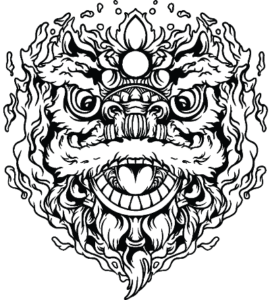In the world of branding, typography is more than just aesthetics—it’s a silent storyteller, shaping perceptions and reinforcing cultural identity. So when a government-backed Indian brand like Tribes India uses a Celtic-inspired font for its wordmark, it naturally sparks curiosity. Is this an intentional design choice, a case of cross-cultural borrowing, or simply an aesthetic decision without deeper historical awareness? In this breakdown, we’ll explore why this typographic selection works despite its unconventional roots, how it aligns with Tribes India’s branding strategy, and what could have been done differently to enhance its impact.
Creative Brand Breakdown of “Tribes India” Wordmark
1. Typography Analysis:
- The font used in the “Tribes India” wordmark appears to be inspired by Uncial or Insular typefaces, which have historic associations with medieval Irish and Celtic scripts.
- The rounded, calligraphic, and flowing letterforms contribute to an organic, handcrafted aesthetic, aligning well with India’s rich artisanal heritage.
- The “n” and “d” confusion raised in the Reddit discussion is valid—since these letters have similar shapes in the typeface, there’s an issue of legibility at first glance, particularly for an international audience.
2. Why It Works (Or Why It Doesn’t)
✅ Cultural Adaptation: The handwritten feel of the font subconsciously mimics the calligraphy of Devanagari, which is why it doesn’t feel entirely out of place in an Indian context.
✅ Luxury & Tradition: High-income Indian consumers, especially those exposed to Western influences, perceive calligraphic, ornate fonts as markers of heritage and premium craftsmanship. This aligns with the market positioning of “Tribes India” as a brand selling traditional, handcrafted tribal goods.
✅ Globalization of Aesthetics: The Indian design industry has been deeply influenced by Western typographic trends, especially through colonization and digital design tools. A Celtic-style typeface might have been intuitively selected without awareness of its origin but purely for its aesthetic appeal.
❌ Historical Mismatch: Uncial scripts have a direct historical link to Irish monastic writing rather than Indian tribal culture. While it works visually, a more regionally appropriate font inspired by Indian calligraphy might have been a better choice.
❌ Legibility Issues: The similarity of letters like “n” and “d” creates a risk of misreading the wordmark, reducing clarity—especially in a fast-moving airport setting.
3. Branding and Marketing Perspective
- Target Audience: Given the placement of this store in an airport, the audience is likely affluent travelers—both domestic and international. The design must balance authenticity with international appeal.
- Psychological Impact: The ornate script evokes a sense of mysticism, heritage, and craftsmanship, which helps sell the idea of tribal products being unique and handmade.
- Possible Improvements:
- Adjust kerning and spacing to improve readability.
- Introduce minor typographic refinements—perhaps incorporating regional Indian calligraphic elements.
- Consider an alternative display font that captures the earthy, tribal, and organic essence without using a distinctly non-Indian typographic style.
4. Location and Market Presence
“Tribes India” operates outlets in several Indian airports, enhancing brand visibility among travelers looking for unique, handcrafted souvenirs. Some known locations include:
- Prayagraj Airport – Second store in the city, focusing on tribal heritage.
- Jaipur International Airport – Showcasing tribal art and culture.
- Cochin International Airport – Located at Terminal 3, Gate Number 5, offering a range of handcrafted tribal products.
Given the international exposure of airport retail spaces, the use of a visually appealing yet globally recognizable script makes sense for attracting tourists and high-end buyers.
5. Conclusion: Aesthetic Over Accuracy
- This wordmark works despite being a Celtic font because it subconsciously mirrors traditional Indian calligraphy.
- It’s an example of cross-cultural aesthetic borrowing, where Western calligraphy is repurposed to align with local sensibilities.
- If improved with minor tweaks, this could be an excellent balance of tradition and modernity for an Indian luxury-heritage brand.




